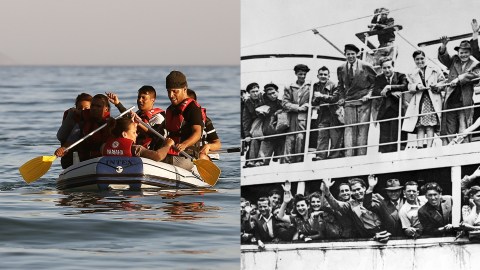Are Syrians Like the Jewish Immigrants Fleeing Germany in 1939?

Following the weekend’s terrorist attacks in Paris, many U.S. states are balking at the idea of welcoming Syrian refugees to their towns and cities. That hesitancy may prove a historical blunder, but it would not be without precedent.
Associate professor of history at Case Western Reserve University, Peter Shulman curates the Twitter account @HistOpinion. His recent tweets shed some essential historical light on the hesitancy to accept a struggling group of migrants in their time of need.
The year is 1939 and the U.S. is considering taking in 10,000 children fleeing Germany—”most of them Jewish.” (The U.S. is currently preparing to accept 10,000 Syrians fleeing their war-torn country). Here is what the public thought at that time:
US Jan 20 ’39: Should the US government permit 10,000 mostly Jewish refugee children to come in from Germany? pic.twitter.com/5cFs5RabQn
— Historical Opinion (@HistOpinion) November 17, 2015
The opinion of U.S. college students at the time was similarly reserved concerning the question: "Should the United States offer a haven in this country for Jewish refugees from Central Europe?"
US Dec 12 ’38: College students: Should the US offer haven in this country for Jewish refugees from Central Europe? pic.twitter.com/KD0c53mKhn
— Historical Opinion (@HistOpinion) November 16, 2015
While certain historical parallels are clear, there is a difference between German Jews and Syrian migrants. As The Washington Post explains:
"To be sure, the United States was emerging from the Great Depression, hardly a climate where ordinary folks welcome immigrants and economic competition. The events of Kristallnacht — a wave of anti-Jewish pogroms in areas controlled by the Nazis — had yet to take place. And the poll's use of the term "political refugees" could have conjured in the minds of the American public images of communists, anarchists, and other perceived ideological threats."
More importantly, we should consider historical examples when we make decisions about the present because they provide some indication of potential outcomes. Historical precedents also offer a point of reference, which, in the immediate aftermath of these violent Paris attacks, help counter the swelling of emotion that prevent cooler heads from prevailing.
While those U.S. states opposed to accepting Syrian immigrants fear that ill-meaning immigrants — read: terrorists — could enter the country with them, there is little actual evidence this is a threat. Authorities say all the Paris attackers are European nationals.
--
Images: KOS, GREECE - AUGUST 31: Migrants from Syria paddle toward shore while completing a journey in a small dinghy crossing a three-mile stretch of the Aegean Sea from Turkey August 31, 2015 in Kos, Greece.
A picture released May 21, 1948 shows jubilating Jewish immigrants arriving in the Holy Land a few days after the proclamation of the State of Israel where they will have to take arms right away to fight against the Arab Legions.





